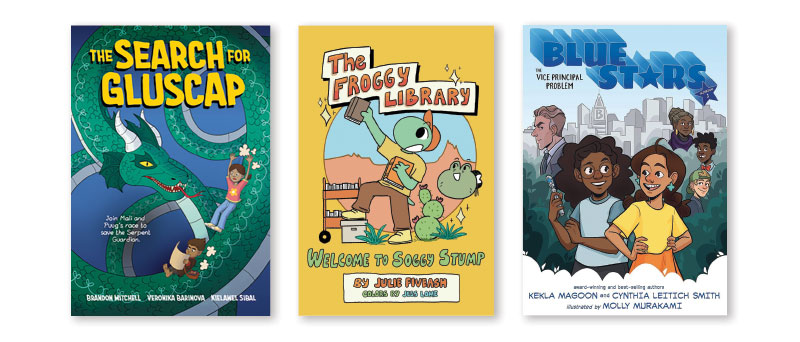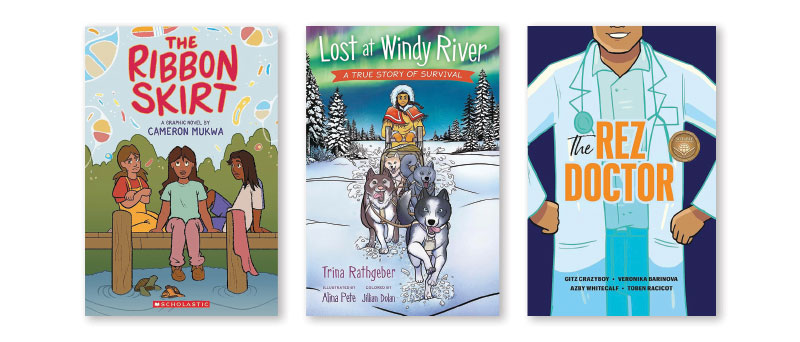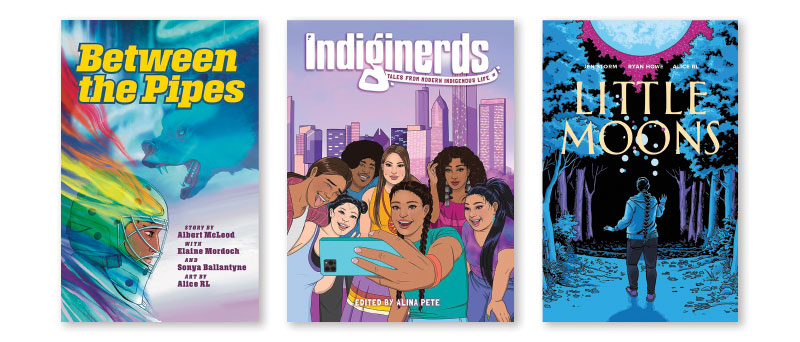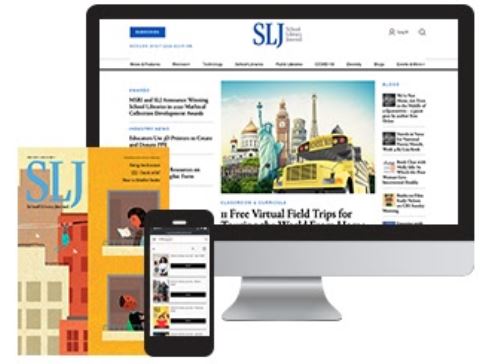9 Contemporary, Indigenous Graphic Novels for Kids and Teens | Stellar Panels
Graphic novels by and about Indigenous people are a growing and essential category. Share these during Native American Heritage Month and all year long.
Graphic novels by and about Indigenous people are a growing and important category. As HighWater Press editor Sasha Bouché pointed out when I interviewed them in 2021, libraries should strive to offer a variety of books about different Indigenous cultures, including those local to them. That way, they said, “students, Indigenous and non-Indigenous alike, get a sense of these lands that are now North America, who was really here and who is still here, what is the culture and what are the languages, what are the stories that belong to these people.”
That’s even more important now than it was in 2021, as factions within and outside the government attempt to suppress truthful portrayals of the history and lives of Native Americans. As Native scholar Debbie Reese wrote in a 2023 SLJ column, “Books by Native writers aren’t just good stories. They are providing non-Native readers with information they have not had access to before. Today’s book bans are taking those books away from all readers.”
The list below is an attempt to provide the variety that Bouché called for. All the books are by Indigenous writers, and some, not all, have Indigenous artists as well. Some are set in reservations or in exclusively Indigenous communities, and with one exception (a fascinating historical tale, Lost at Windy River), these are stories of contemporary life—something that Bouchépointed out as particularly important. “There is this ongoing idea that colonialism is over,” they said, “but it’s still a continuing process, and it’s important for Indigenous people, especially young Indigenous kids, to see themselves represented in stories where they are joyful or stories where they are portrayed as heroes.”

MITCHELL, Brandon. The Search for Gluscap. illus. by Veronika Barinova. HighWater Pr. May 2026. ISBN 9781774920510.
Gr 1-3–Mali, a Mi’kmaq girl, and her magical friend Puug search for Gluscap, the protector of all living things, in order to save the serpent who is the guardian of their river, bring back the salmon that seem to be disappearing, and restore balance to the land. Once upon a time, Mali’s father tells her, giant beavers dammed up the river so the salmon couldn’t spawn. Gluscap stopped them, throwing the biggest beaver to the ground so hard that it became a mountain, and shrinking the others so they were too small to disrupt the river. Puug fills in a later part of the story, explaining that strangers came and built a lumber mill that poisoned the river and the serpent that was its guardian. Mali and Puug work with the animals of the region, including the still-recalcitrant beavers, to locate Gluscap and capture the serpent, so he can heal it. This graphic novel offers several interesting details—notably the story of Gluscap and the beavers is told twice, with two different art styles and slightly different emphases—and places a strong focus on maintaining nature’s balance. The art is simple, with little detail, which makes the story easy to follow, and the animals have especially expressive faces. Some of the dialogue is in Mi’kmaq (Mitchell’s heritage) with an English translation included in the same panel.
FIVEASH, Julie. The Froggy Library. illus. by author. Levine Querido. Apr. 2026. ISBN 9781646146352.
Gr 3-7–Fiveash, a nonbinary Diné (Navajo) cartoonist and a former librarian, has created a masterly, multifaceted story filled with delightful characters and relatable emotions that also weaves in serious discussions about keeping traditions alive in the modern world. The setting is based on the Navajo reservation in Arizona and New Mexico, and there are numerous cultural references that Fiveash cleverly transmutes into a world of frogs. Anura, who is nonbinary, arrives to visit Grandma Juniper in the desert town of Soggy Stump, and with a little nudge from her, takes a job at the local library. There they not only beef up the manga collection but also start a community archive, with guidance from Fern, the librarian. Anura’s explorations include talking to Grandma’s friend Olive, who weaves traditional rugs, and visiting a community garden and the local comic shop, where they learn to make a zine. The tone of the story shifts about two-thirds of the way through from cheery and upbeat to more serious when Grandma Juniper has an asthma attack and goes into hospice. As Anura is trying to process this, Grandma Juniper comes to them in a dream and talks about the importance of the experiences they have had, as well as those yet to come. This is a thoughtful and sensitive approach to the subject of dying and death. The story is filled with references to Navajo culture, including vocabulary, food, and traditions, all embedded in a modern world where Grandma Juniper and Olive go to the casino and the teens read manga with punning titles, such as Frogmetal Alchemist. The artwork is simple and more expressive than realistic. The dialogue gets deep at times, as the characters have conversations about aging, death, memories, and traditions, but it stays natural and simple enough that even younger readers will be able to understand it, while older readers and those familiar with Diné tradition will get more from the puns and cultural references.
MAGOON, Kekla & Cynthia Leitich Smith. Blue Stars: Mission One: The Vice Principal Problem. illus. by Molly Murakami. Candlewick. 2024. ISBN 9781536204995.
Gr 4 Up–Riley Halfmoon grew up in a big Muscogee family in Oklahoma. Her cousin, Maya Dawn, who is not Indigenous, has traveled all over the world with her parents. Now, thanks to job changes, the two of them are living with their grandmother and Riley’s parents in a big city that’s very different from what they are used to. The cousins also have contrasting personalities: Riley is energetic and gregarious; Maya is quieter and nerdy. Riley does gymnastics. Maya is in the robotics club. The going is rough at first, but then the two unite against a common enemy: Mr. Balderdash, their middle school vice principal, who prefers sending kids to detention instead of funding their clubs and activities. The story is funny, and the girls are creative, each using special skills to accomplish their mission. The art is energetic, colorful, and a bit cartoony, with expressive characters and lots of action.

MUKWA, Cameron. The Ribbon Skirt. illus. by author. Scholastic/Graphix. 2024. ISBN 9781338843262.
Gr 4-8–Anang, a nonbinary 10-year-old, wants to wear a ribbon skirt, traditionally worn by Anishinaabe women, at the annual powwow. They are fortunate to have the support of loving grandparents, but their best friend Sherry has a hard time with the changes she has seen in her friend, which came at a time when her own parents were getting a divorce. After dreaming about the skirt, Anang sets out to find the materials they need to create it, getting help and encouragement from animal spirits along the way. As Sherry accompanies Anang on these adventures, she gradually comes to accept her two-spirit friend and gathers the courage to apologize for speaking hurtfully to them. The art is simple, with heavy lines and flat areas of color that suggest stained glass, although it becomes softer and more subtle when the spirits appear. Back matter includes a glossary and a description of the history of the ribbon skirt, as well as an explanation of the origin and meaning of the term two-spirit.
RATHGEBER, Trina. Lost at Windy River: A True Story of Survival. illus. by Alina Pete & Jillian Dolan. Orca. 2024. ISBN 9781459832268.
Gr3-7–At the age of 13, Ilse Schweder(the author’s grandmother) went out with her father and brothers to check a trapline in the Arctic tundra and got separated from the others. For nine days she wandered through the cold and unforgiving land, a place with few landmarks and many hazards, before reaching the cabin of a fur trapper who rescued her and brought her home. Schweder, whose mother was Cree, survives by using the skills she spent all her life learning: eating spruce sap and cranberries, followinga trail left by caribou, and pressing her fur boots into the snow to dry them. Along the way, the author explains the Cree folkways and legends that would have been an ordinary part of Ilse’s life. The art is comic book–realistic, but Pete also uses a more figurative style reminiscent of Indigenous art when depicting Cree legends and lore. Non-Indigenous writer Farley Mowat included Ilse’s story in one of his books, but he lacked the deep understanding of the land and its people that Ilse possessed. This book is her granddaughter’s way of reclaiming the story.
CRAZYBOY, Gitz. The Rez Doctor. illus. by Veronika Barinova, Azby Whitecalf & Toben Racicot. HighWater Pr. 2024. ISBN 9781553799245.
Gr 8 Up–European-based medical systems often mistreated Indigenous people, stripping them of their dignity and their rights as well. As a boy growing up on the Blackfoot reservation, Ryan sees how his doctor treats him and his mother, and how he is treated differently than the non-Indigenous kids in his school. This contrasts with the warmth of his family life, where he always felt safe and loved. He witnesses a tribal ceremony at a tipi camp, in which the elders bestow a feather bonnet on a man who turned his life around. Inspired by a Blackfoot doctor who speaks at his high school, Ryan decides he wants to become a doctor too, but the temptations of college often overcome his good intentions. When his girlfriend tells him she is pregnant, and his uncle goes to prison, he returns to the tipi camp and prays to his ancestors for help. This gives him the strength to focus on work and school, and he eventually gets his medical degree. The story ends as it began, in a doctor’s office, but with Ryan treating his patients with respect and dignity. The artwork, like the story, is straightforward and easy to follow.

MCLEOD, Albert with Elaine Mordoch & Sonya Ballantyne. Between the Pipes. illus. by Alice RL. HighWater Pr. 2024. ISBN 9781774921043.
Gr 7 Up–Thirteen-year-old Chase is the goalie on his school hockey team, but lately his game has been off. He’s gay but in the closet, and his teammate Leo has been taunting him, calling him slurs and making digs about his best friend, Kevin. Because of the bullying, he cuts off Kevin, alienates a female friend by trying to kiss her, and yells at his grandmother. Somehow, though, his grandmother knows what to do and takes him canoeing with Dot, a two-spirit filmmaker, and Eddi, a two-spirit elder. Spending time with them in nature, talking about their heritage and traditions, gives Chase the strength to accept who he is and the confidence to know there will be a place for him in the world. He even gets the courage to call out Leo on his bullying. Chase is Cree, and the characters use Cree terms for relatives and traditions. The art is colorful and particularly powerful during the nature and dream sequences. McLeod is Cree and Métis and is a longtime human rights activist.
PETE, Alina, ed. Indiginerds. Iron Circus. 2024. ISBN 9781638991335.
Gr 8 Up–The stories in this high-spirited anthology are of young Indigenous people incorporating their culture with their nerdy enthusiasms, whether by decolonizing role-playing games, such as Dungeons & Dragons; setting up a pirate radio station; or creating a website for horror reviews by Indigenous writers. Some of the stories show creative ways to share and preserve their culture, such as the Twitch streamer who uses her channel to share her native language and improve her own mastery of it. The stories feature a wide variety of art styles, storytelling types, and levels of seriousness; some are lighthearted, while others speak of depression, alcoholism, and oppression. Despite some dark moments, this book is filled with the enthusiasm of young people who are deeply involved in both their Indigenous communities and the wider ones of gaming, streaming, music, and more.
STORM, Jen. Little Moons. illus. by Ryan Howe. HighWater Pr. 2024. ISBN 9781774921074.
Gr 9 Up–The disappearance of Indigenous women is a crisis that has received increased attention in recent years. This graphic novel shows an Ojibwe family coping with the loss of a daughter who doesn’t come home from school one day and is never heard from again. Reanna is a middle child with a younger brother, Theo, who doesn’t talk much, and an older sister, Chelsea, whom she looks up to. When Chelsea goes missing, and it becomes increasingly clear that something terrible has happened, each member of the family copes in their own way. Her mother leaves the reservation and tries to move on, but Reanna and Theo move in with their father, and while they grieve, they also feel their sister’s presence. Like many of the other books described here, this graphic novel is drawn in a realistic comic book style. Chelsea’s fate is never revealed, but the family does come to terms with it in their own way, and the story concludes with them gathering to light a sacred fire.

RELATED
The job outlook in 2030: Librarians will be in demand
The job outlook in 2030: Librarians will be in demand
ALREADY A SUBSCRIBER? LOG IN
We are currently offering this content for free. Sign up now to activate your personal profile, where you can save articles for future viewing






Add Comment :-
Be the first reader to comment.
Comment Policy:
Comment should not be empty !!!